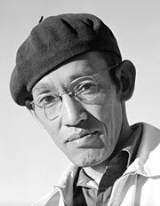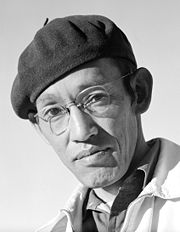
Toyo Miyatake
Encyclopedia

Japanese American
are American people of Japanese heritage. Japanese Americans have historically been among the three largest Asian American communities, but in recent decades have become the sixth largest group at roughly 1,204,205, including those of mixed-race or mixed-ethnicity...
photographer, best known for his photographs documenting the Japanese American
Japanese American
are American people of Japanese heritage. Japanese Americans have historically been among the three largest Asian American communities, but in recent decades have become the sixth largest group at roughly 1,204,205, including those of mixed-race or mixed-ethnicity...
people and the Japanese American internment
Japanese American internment
Japanese-American internment was the relocation and internment by the United States government in 1942 of approximately 110,000 Japanese Americans and Japanese who lived along the Pacific coast of the United States to camps called "War Relocation Camps," in the wake of Imperial Japan's attack on...
at Manzanar
Manzanar
Manzanar is most widely known as the site of one of ten camps where over 110,000 Japanese Americans were imprisoned during World War II. Located at the foot of the Sierra Nevada in California's Owens Valley between the towns of Lone Pine to the south and Independence to the north, it is...
during WWII
World War II
World War II, or the Second World War , was a global conflict lasting from 1939 to 1945, involving most of the world's nations—including all of the great powers—eventually forming two opposing military alliances: the Allies and the Axis...
.
Life
Miyatake was born in KagawaKagawa Prefecture
is a prefecture of Japan located on Shikoku island. The capital is Takamatsu.- History :Kagawa was formerly known as Sanuki Province.For a brief period between August 1876 and December 1888, Kagawa was made a part of Ehime Prefecture.-Battle of Yashima:...
, Shikoku
Shikoku
is the smallest and least populous of the four main islands of Japan, located south of Honshū and east of the island of Kyūshū. Its ancient names include Iyo-no-futana-shima , Iyo-shima , and Futana-shima...
in Japan
Japan
Japan is an island nation in East Asia. Located in the Pacific Ocean, it lies to the east of the Sea of Japan, China, North Korea, South Korea and Russia, stretching from the Sea of Okhotsk in the north to the East China Sea and Taiwan in the south...
in 1896. In 1909 he migrated to the United States to join his father. He settled in the Little Tokyo section of Los Angeles, California.
With an interest in arts — most notably photography, which he studied under Harry K. Shigeta — Miyatake began associating with the local arts community. In 1923 he bought his photo studio. Miyatake encouraged fellow photographer Edward Weston
Edward Weston
Edward Henry Weston was a 20th century American photographer. He has been called "one of the most innovative and influential American photographers…" and "one of the masters of 20th century photography." Over the course of his forty-year career Weston photographed an increasingly expansive set of...
to exhibit his work and Miyatake is credited as giving Weston his first gallery showing.
At the time Miyatake met his future wife, his brother was courting her. He began spending time with Hiro under the guise that he was using her as a model. His brother was crushed; it is said that he "died of a broken heart" at an early age.
Before World War II, Miyatake's photography won awards as he photographed various personalities.
During World War II Miyatake was interned at Manzanar
Manzanar
Manzanar is most widely known as the site of one of ten camps where over 110,000 Japanese Americans were imprisoned during World War II. Located at the foot of the Sierra Nevada in California's Owens Valley between the towns of Lone Pine to the south and Independence to the north, it is...
relocation camp in the Owens Valley. He smuggled a camera lens into the camp and constructed a camera body from wood. The pictures he secretly took at the camp are among the relatively few that show the plight of the U.S. citizen detainees.
After the war, the family returned to Los Angeles, where their home had been entrusted to some of their white friends during the internment. Unlike many families who lost their homes, the Miyatakes were able to resume their life and provide shelter to a few less fortunate internees and their families. In post-war Little Tokyo, many residents were unable to afford Miyatake's services and some opted instead to barter goods to have him photograph weddings and portraits. With his wife Hiro running the front office, she once negotiated his services for a Steinway
Steinway & Sons
Steinway & Sons, also known as Steinway , is an American and German manufacturer of handmade pianos, founded 1853 in Manhattan in New York City by German immigrant Heinrich Engelhard Steinweg...
piano and another time, she negotiated for a litter of poodle
Poodle
The Poodle is a breed of dog. The poodle breed is found officially in toy, miniature, and standard sizes, with many coat colors. Originally bred as a type of water dog, the poodle is highly intelligent and skillful in many dog sports, including agility, obedience, tracking, and even herding...
s.
After the death of his Hiro in 1971, Miyatake moved from his home on Third Street in East Los Angeles
East Los Angeles (region)
East Los Angeles is the portion of the City of Los Angeles that lies east of Downtown Los Angeles, the Los Angeles River and the unincorporated areas of Lincoln Heights, west of the San Gabriel Valley, East Los Angeles and City Terrace, south of Cypress Park, and north of Vernon, California and...
to live in neighboring Monterey Park
Monterey Park, California
Monterey Park is a city in Los Angeles County, California, United States, east of downtown Los Angeles. The city's motto is "Pride in the past, Faith in the future"...
with his daughter and her family.
He remained active in the studio throughout this period. In the early morning, Miyatake could be seen walking around Monterey Highlands Elementary School for exercise. The last image he captured on film was taken at this park. The film was discovered and processed after his death.
Before his death in 1979, Miyatake and Ansel Adams
Ansel Adams
Ansel Easton Adams was an American photographer and environmentalist, best known for his black-and-white photographs of the American West, especially in Yosemite National Park....
produced a book, Two Views of Manzanar, a compilation of their photographs during the internment.
Miyatake's cremated remains are buried at Evergreen Cemetery in Boyle Heights; a portion of his remains are stored in the Koyasan Buddhist Temple
Koyasan Buddhist Temple
, also known as Koyasan Buddhist Temple, is a temple located in Los Angeles, California in Little Tokyo. Founded in 1912, it is one of the oldest existing Buddhist temples in the North American region, and possibly the first Vajrayana Buddhist temple established in America before the emergence of...
in Little Tokyo.
Offspring
All of Miyatake's children were involved in photography and the family business. Archie, the eldest son, ran the family studio after Tōyō's death in 1979. Robert Miyatake worked in the studio and later opened his own photographic color lab in South Pasadena, CaliforniaPasadena, California
Pasadena is a city in Los Angeles County, California, United States. Although famous for hosting the annual Rose Bowl football game and Tournament of Roses Parade, Pasadena is the home to many scientific and cultural institutions, including the California Institute of Technology , the Jet...
. Richard (Tabo) worked in the family studio as well and left to work in photographic production. Youngest child and only daughter, Minnie, also worked in the studio performing clerical and business-related duties and currently serves on the Board of Trustees at Koyasan Buddhist Temple, where her father's remains are stored. A handful of Miyatake's grandchildren continue the tradition to this day.
Gary Miyatake, the eldest grandson and the last to be trained in the family business by the master Toyo, runs Toyo Photography Studio in Gardena, California.
Miscellaneous
One of Miyatake's prized possessions was his white 1957 Ford ThunderbirdFord Thunderbird
The Thunderbird , is an automobile manufactured by the Ford Motor Company in the United States over eleven model generations from 1955 through 2005...
, which now belongs to his youngest grandson, Mark Takahashi.
Miyatake was easily recognizable in Little Tokyo, wearing his trademark black beret
Beret
A beret is a soft, round, flat-crowned hat, designated a "cap", usually of woven, hand-knitted wool, crocheted cotton, or wool felt, or acrylic fiber....
and bowtie.
In the TV movie Farewell to Manzanar
Farewell to Manzanar
Farewell to Manzanar is a memoir published in 1973 by Jeanne Wakatsuki Houston and James D. Houston. It was adapted in the form of a television movie in 1976 starring Yuki Shimoda, Nobu McCarthy, Pat Morita, and Mako....
, Pat Morita
Pat Morita
Noriyuki "Pat" Morita was an American actor of Japanese descent who was well-known for playing the roles of Matsuo "Arnold" Takahashi on Happy Days and Mr. Miyagi in the The Karate Kid movie series, for which he was nominated for the Academy Award for Best Supporting Actor in 1984.-Early life:Pat...
portrays Zenahiro, a character based on Miyatake.
In 2002, Robert A. Nakamura
Robert A. Nakamura
Robert Akira Nakamura is a pioneering filmmaker and teacher, sometimes referred to as "the Godfather of Asian American media." In 1970 he co-founded Visual Communications the oldest community-based Asian Pacific American media arts organization in the United States.-Personal:Nakamura was born in...
made the film, Toyo Miyatake: Infinite Shades of Gray, documenting the photographer's life and work.
In 2009, the film, Toyo's Camera was released, documenting the internment of Japanese Americans during World War II through the perspective of the photographer's images. Narrated by George Takei
George Takei
George Hosato Takei Altman is an American actor, author, social activist and former civil politician. He is best known for his role in the television series Star Trek and its film spinoffs, in which he played Hikaru Sulu, helmsman of the...
, music by Kitaro
Kitaro
, better known as , is an award winning Japanese musician, composer and multi-instrumentalist who is regarded as one of the pioneers of new age music.-Early life:...
. http://www.toyoscamera.com/
Books by Miyatake
- Ansel Adams and Toyo Miyatake, Two Views of Manzanar, Los Angeles : Frederick S. Wight Art Gallery, UCLA, c. 1978. Shashinka Miyatake Tōyō no sekai: Renzu ga toraeta ningen no kiroku: 50-nen no nichibei-kōryū-shi (写真家宮武東洋の世界:レンズがとらえた人間の記録:50年の日米交流史). Tokyo: Bungeishunjū, 1980. Miyatake Tōyō no shashin: 1923–1979 (宮武東洋の写真:1923~1979). Tokyo: Bungeishunjū, 1984.

